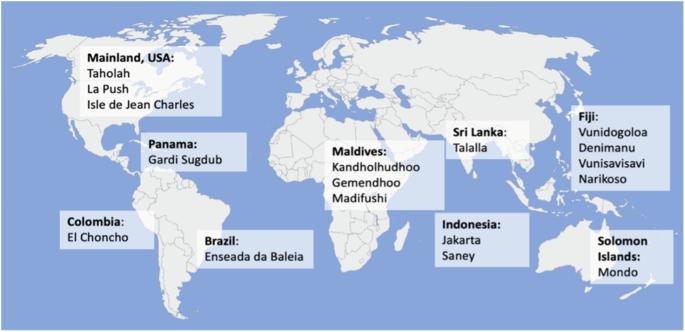Planned relocation may reduce communities’ future exposure to coastal inundation but effect varies with emission scenario and geography
IF 8.1
1区 地球科学
Q1 ENVIRONMENTAL SCIENCES
引用次数: 0
Abstract
The planned, permanent relocation of entire communities away from sea level rise (SLR) and coastal floods is an already occurring climate change adaptation strategy. Yet, planned relocations are fraught undertakings with multiple goals, and may or may not achieve their most basic objective: to reduce risk. Here we assess risk of future coastal flooding before and after moving, for three dates and three emissions scenarios, for 17 communities from a global dataset. Most communities achieved exposure reduction with less future inundation in destinations than origin sites, but the extent varies across time and emissions scenario. In all cases, origin sites have projected exposure to SLR plus a once-per-year flood, with increasing exposure under high emissions scenarios and towards 2100. In nine cases, even destination sites have projected inundation exposure under some scenarios. Small-island-to-small-island relocations had more projected inundation in destinations than moves from a small-island-to-mainland, or from mainland-to-mainland. Planned relocations reduce communities’ risk of future coastal floods, but they do not eliminate it entirely – especially under high emissions scenarios and for moves with small-island destinations, according to an analysis that combines data on relocation sites and inundation projections.

有计划的搬迁可能会减少社区未来遭受沿海淹没的风险,但效果因排放情景和地理位置而异
有计划地永久性迁移整个社区,使其远离海平面上升(SLR)和沿海洪水,是一种已经出现的气候变化适应战略。然而,有计划的搬迁是一项具有多重目标的复杂工作,可能实现也可能无法实现其最基本的目标:降低风险。在此,我们评估了全球数据集中 17 个社区在搬迁前后、三个日期和三种排放情景下的未来沿海洪水风险。大多数社区都实现了风险的降低,目的地的未来淹没程度低于原籍地,但不同时间和排放情景下的程度各不相同。在所有情况下,原发地预计都会受到可持续土地退化和每年一次洪水的影响,在高排放情景下和 2100 年前,影响程度会越来越大。在九种情况下,甚至目的地也会在某些情景下受到洪水的影响。小岛屿到小岛屿的搬迁比小岛屿到主岛的搬迁或大陆到大陆的搬迁对目的地的预计淹没程度更高。根据一项综合了搬迁地点和洪水预测数据的分析,计划搬迁可以降低社区未来遭受沿海洪水的风险,但并不能完全消除这种风险--尤其是在高排放情景下和搬迁目的地为小岛屿的情况下。
本文章由计算机程序翻译,如有差异,请以英文原文为准。
求助全文
约1分钟内获得全文
求助全文
来源期刊

Communications Earth & Environment
Earth and Planetary Sciences-General Earth and Planetary Sciences
CiteScore
8.60
自引率
2.50%
发文量
269
审稿时长
26 weeks
期刊介绍:
Communications Earth & Environment is an open access journal from Nature Portfolio publishing high-quality research, reviews and commentary in all areas of the Earth, environmental and planetary sciences. Research papers published by the journal represent significant advances that bring new insight to a specialized area in Earth science, planetary science or environmental science.
Communications Earth & Environment has a 2-year impact factor of 7.9 (2022 Journal Citation Reports®). Articles published in the journal in 2022 were downloaded 1,412,858 times. Median time from submission to the first editorial decision is 8 days.
 求助内容:
求助内容: 应助结果提醒方式:
应助结果提醒方式:


